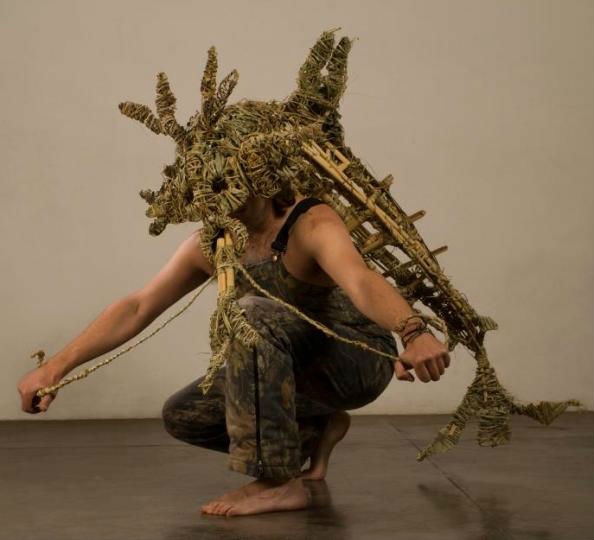
by Ximena Jordán
The exception
I approached the work of Francisco Rios in a different way, from a distance. This is a method of aesthetic research that I usually discard. But for the present article I confronted images and other sources of information, which, as reliable as they might be, can never replace, in my opinion, the direct appreciation of the work. However, technology gives us options that shorten distance. Among them, the opportunity to converse extensively online with the artist, whose explanation vitalizes the images of his work and enriches the reading of them. What happened this time? Why did I break my general rule of directly appreciating the work of art of which I write?
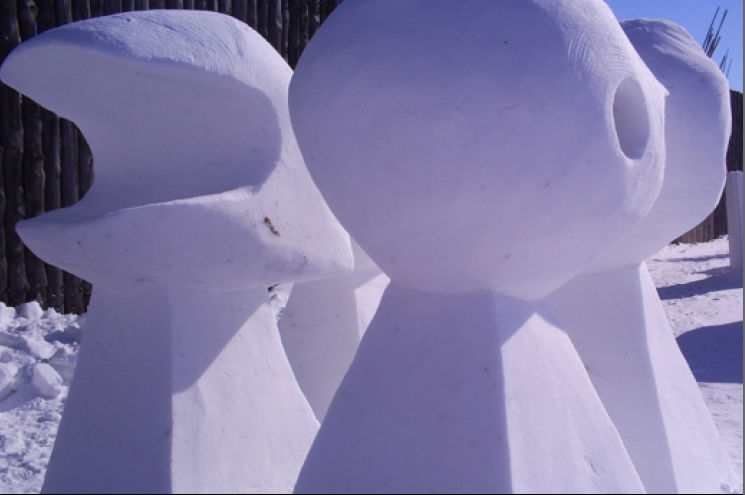
The work of Francisco Ríos condenses what has been my subject of interest and study for years in such an obvious way, that I succumbed to the temptation to interpret it at a distance, despite the impossibility of witnessing it first-hand, since Francisco, a Chilean sculptor, works and resides in his country of origin and I am in Mexico. His work delicately harmonizes the concepts of myth and art, a parity that is undoubtedly a "commonplace" in what we call pre-contact art with the West.
The art executed by non-Western cultures, before receiving the direct and determining influence of the West, is itself sacred and profane at the same time. It emphasizes in some pieces the sacred and in some the profane, but always contemplating both forces as essentially present. However, contemporary art, both indigenous and Western, cannot be described as the same.
Contemporary Indian art presents a mythological component in many of its manifestations, but not in all; not as a general rule. This option is congruent with its quality of indigenous art, but at the same time contemporary; dual quality that gives the artist the freedom to respond to only certain patterns of ethnicity, and others not, as appropriate to the creation of a particular work. That is to say, in contemporary Indian art, the proportionality of the sacred and the profane varies in each creation, from a prevailing sacredness to a non-existent one. Contemporary Western art, at the other extreme, is mostly secular; it could even be said that when it presents an apparent sacredness it is usually with the intention of making an citation or cultural criticism, instead of producing a reconnection of the spectator with another dimension of existence.

Where does the work of Rios fit? That's the interesting thing. We could say that Francisco Rios makes contemporary art (and very contemporary, including genres such as performance, ephemeral art and "living sculpture") in which he visually investigates mythologies of people that do not belong to their cultural matrix, either extinct, as is the case of the Paracas culture (ancient Peru, 700 BC to about 200 AD) or is still in force, as is the case of Ríos' inquiry into Chilota mythology.
The choice of myths that Rios investigates does not follow a historical, geographical, or chronological order. Rather it obeys the order of life itself, that is to say, the unpredictable and perfect sequence according to which the various mythical stories are manifested to the artist, linked to certain spaces, objects or even people who make direct reference to them and from which Ríos is inspired to create. In this way, Ríos generates his creations from the direct contact with the referent of the myth with which he is in the present, reference that varies from a complete archaeological site to a (still) decipherable embroidered in a textile.
This mythological referent is the trigger for an experience of inter-religiosity in the artist, an experience from which the visual research that gives rise to the work of Ríos is born, which nevertheless remains Western and contemporary, nevertheless endowed with of the cultural and substantial solidity that only the relation with the myth can provide. This statement is in agreement with the well-known mythologist Joseph Campbell (The Masks of God, 1991, p. 671), who states that "the norms of myth, understood rather as 'elementary' than 'ethnic' medium of the intelligent use not of a mythology, but of all dead and fixed mythologies, will allow the individual to anticipate and activate within himself the centers of his own creative imagination, from which his own myth can then be deployed."
Interestingly, and probably without the need to know the postulates of Campbell, Francisco Rios, from his artistic being, perceives the same as this mythologist, confessing that the magnetism caused by the stories and mythical characters that appear in his path, both artistic and personal, is not due to their quality as representatives of a historical past that is necessary to know by "general culture". Rather, they become magnetic because these mythological referents connect him, Rios himself and, consequently, his art, with both spiritual and material matters of society and the present time in which he lives and in which he unfolds and manifests his work.
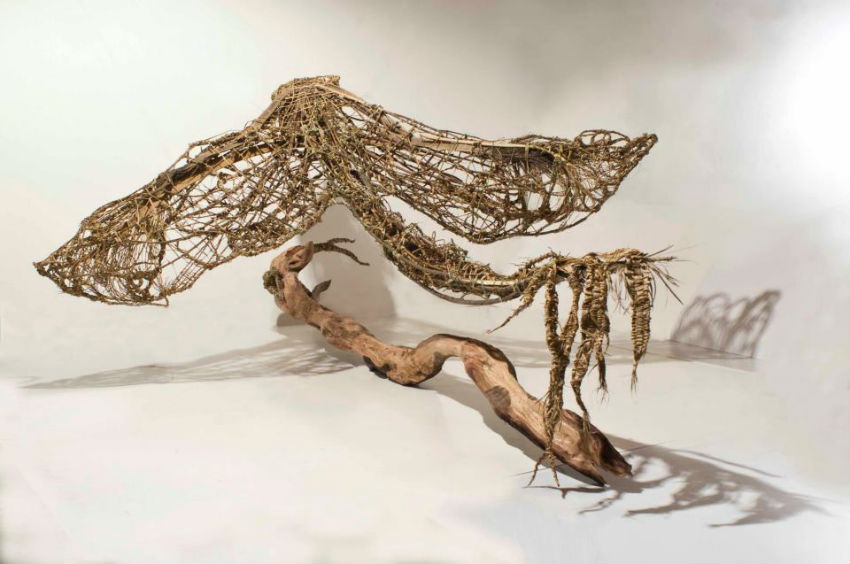
The divine lives within you. Live from your center.
-Joseph Campbell
How did this indigenous-mythological concern arise in Ríos? When he was in middle school, that is, at school, during his adolescence, during summer jobs, he was invited to participate in a Mapuche ceremony to which not many huincas (white men) were invited. As a result of this experience, he began his interest in cultures alternative to his own. This interest continued to increase, until these ciltural aspects showed up aesthetically and visually in his works of art, which are explorations of indigenous mysticism through and through contemporary aesthetics. As I mentioned earlier, these explorations are materialized in pieces of art of different styles. Being my favorite "living sculptures," I gave myself the license to "baptize" a series of sculptures in vegetal fiber that Ríos creates in such a way that they can be adapted to the human body to be able to embody them and to grant them, temporarily, "moving life".
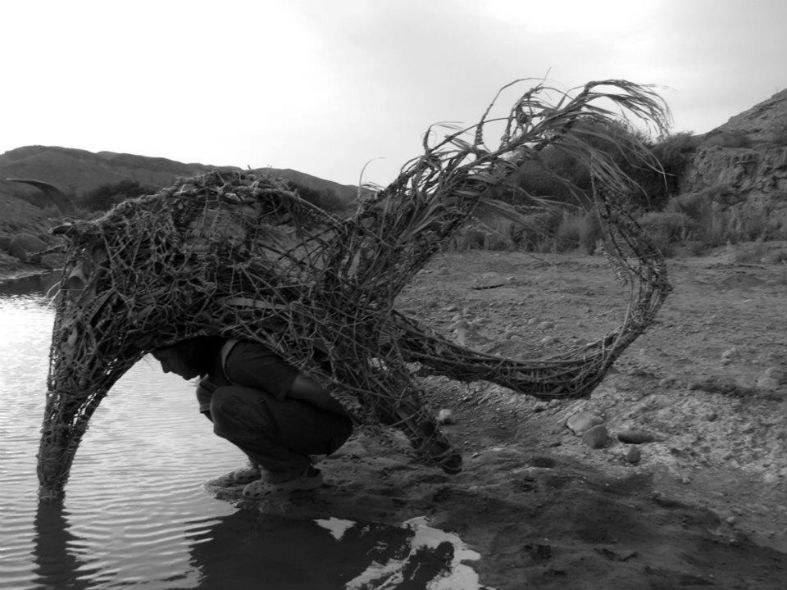
by taking on life and movement, the characters created travel mysteriously in the openings in which Francisco Ríos exposes and they dance for a space, both physical and sacred. Among these characters we find the Imbunche of Chilote origin, the Ocular God, of Paracas origin, the Camahueto, of Huilliche origin and Choike, of the Mapuche culture. Rather than give them life himself, Francisco Rios, curiously, prefers to leave these characters (called graciously and affectionately by him as his "superheroes") in bodies of scenic art professionals, "I prefer that those who have better mastery of the body enliven my sculptures, so I can better appreciate the spirit that I managed to infiltrate them with my work on the material," he admits.

At present and in parallel to his contemporary-mythological creations, Francisco Ríos is also dedicated to artistic education, through which he takes advantage of familiarizing the new generations with mythological mysteries that know no generation or chronology. "The little ones understand easily what I teach them of the myths. They understand the forces that represent the animals. They understand the presence of the divine of the nature," he confesses. And there is awe in his voice.
The work of Francisco Ríos contributes to the revitalization of aesthetics and culture, revitalizing mythologies that run the risk of not continuing in memory. They run the risk of being forgotten if they are not endowed with contemporary forms such as those used by Ríos, which allow the society to appropriate them and give them meaning. Who better than the artists, who speak in the same aesthetic, symbolic and metaphorical language of the myths, to endow them with the morphology to the myths themselves? This is what Campbell suggests, by way of questioning: "Could mythology have emanated from other minds, if not from the minds of artists?" (1991, p.472).
**************
Francisco will perform at the Bellas Artes on Wednesday, November 1 at 8pm for the official inauguration of the La Calaca Festival, and will also beperforming on Thursday, November 2 at Plaza Civica at 6pm for the ceremony of the Pyramid of the Dead.
**************
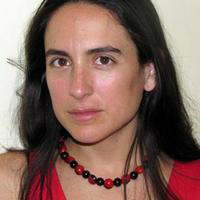
Ximena Jordán: RR.PP Atanor Creative Master in art curatoship by The University of Melbourne. Degree in Arts (Philosophy of Art) by the Pontifical Catholic University of Chile (PUC) Cultural columnist and coordinator of cultural events
Images: provided by the artist Francisco Ríos Araya.
You must register and log in to write a comment.
Please use the "login" link at the top (right) of the page.
|